New Extraordinary Megamouth Exhibit Added To International Cryptozoology Museum
Posted by: Loren Coleman on November 23rd, 2011
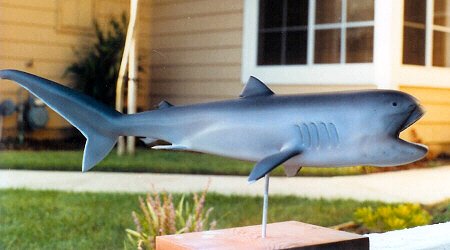
The International Cryptozoology Museum is proud to announce that it is only the second museum in the world to place on display a model (above) of the first ever megamouth shark (below) to be discovered. This model by Hill Studios was made from the first animal that was captured in 1976. The International Cryptozoology Museum’s model is the second casting. The Waikiki Aquarium in Hawaii has the original and the first casting. The new megamouth display officially goes on exhibit on November 30th, in Portland, Maine.
The first megamouth shark was discovered, secretly, 35 years ago, by the U.S. Navy.
The ICM is delighted to add this remarkable item to the exhibits in Portland, Maine. It is a donation of the permanent Loren Coleman collection for the educational and viewing enlightenment of the general public, regarding one of the largest new species to be found in the oceans in recent years.
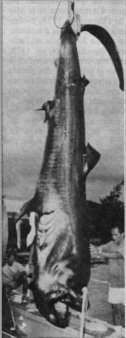
The megamouth shark (Megachasma pelagios) is an extremely rare species of deepwater shark.
Since its discovery in 1976, only a few megamouth sharks have been seen, with 53 specimens (see total list, here) known to have been caught or sighted as of 2011, including three recordings on film. Like the basking shark and whale shark, it is a filter feeder, and swims with its enormous mouth wide open, filtering water for plankton and jellyfish. It is distinctive for its large head with rubbery lips. It is so unlike any other type of shark that it is classified in its own family Megachasmidae, though it has been suggested that it may belong in the family Cetorhinidae of which the basking shark is currently the sole member.
The first megamouth was captured on November 15, 1976 about 25 miles off the coast from Kaneohe, Hawaii when it became entangled in the sea anchor of a United States Navy ship. Examination of the 14 1/2-foot (4.5-m), 1650-pound (750-kilogram) specimen by Leighton Taylor showed it to be an entirely unknown type of shark, making it one of the more sensational discoveries in 20th-century ichthyology (perhaps second only to the coelacanth).
The International Cryptozoology Museum, located at 11 Avon Street, Portland, Maine, has over 3000 displayed items of new species and unknown or hidden animals that may remain to be discovered. Along with the new display of the megamouth, the museum also has full-scale models of the dynamic blue 5.5 feet long coelacanth first discovered off Africa in 1938, and the flaming red 14 feet long colossal squid found off New Zealand in 2007.
++++++++++++++++++
The original news release on the discovery of
Megamouth Shark #1
November 15, 1976
(see photos at end of story)
On November 15, 1976 I tied a figure-8 slip knot around the caudal peduncle of a megamouthshark resulting in its capture. This was the first recorded specimen of this order, family, genus and species ever taken. The fish was totally unknown before this day.
This event went unheralded for many years because it was a classified operation for the U.S. Navy. The Cold War was still on and we were monitoring Soviet submarine activity. We deployed a sonar array three miles long at a depth of 500′ over a three day period. At each deep end were sand bags to keep it down and a parachutes, acting as a sea anchors, to prevent the array from fouling into a bird nest. The array had a retrieval line attached to it, leading to the surface with a buoy on it for recovery.
The mission was ending and all we had to do was retrieve the gear. But the shark ate one of the parachutes – he must have thought it was a food source. The parachutes we were using had alternating orange and white panels. I don’t know if that had any special significance because of the 500′ depth. At 100′ red and orange colors are lost, at 300′ blues and greens are lost and any colors then turn to purple; it gets pretty dark after that.
I was a civilian contractor (for the Naval Undersea Center at the Kaneohe Bay Marine Corps Air Station on Oahu. I was a crewman on a semi-submersible platform (SSP) called the SSP Kaimolino, a SSP prototype that was always breaking down.
If there was a special irony in this for me, it was that I’d just been fired.
This was my last day on the job.I was to return to the Hawaiian sport fishing trade, where I’d been working as a deckhand for the previous three years.
On board the TRB was a scientific team from the University of Houston. They had developed a long range sonar system and were trying to sell it to the Navy. We were over thirty miles north of Oahu, well off the 1,000 fathom ledge, on the abyssal plain.
A word about this sonar apparatus might be of interest. Powered by pieso-electric crystals, one element sent out signals and another element would receive the echoes through the same antenna. We actually had a little dingy on the surface tethered to the array. In its watertight hull was housed a 10 hour reel-to-reel tape machine to record the receiver’s data. We would recover it at the end of each day – it was a three day project. These strong signals go until some subsea structure breaks them up and disperses them. In this case from the Hawaii area to the Japanese Isles, the Aleutian Isles and half way to the continental US west coast, but the mid-Pacific ridge scattered the signals.
Swimming into this web of technology came a hungry 16′ shark. He had eyes the size of softballs to pierce the purple gloom, both jaws dotted with phosphorescent photophores that glowed to attract krill (small shrimp-like creatures) and a tongue the size of a man to gulp down whatever he could lure. He also had two claspers for mating (I guess he needed a spare). These claspers can be seen in the first photo when he’s lying on the sloping deck of the TRP. There is also a deep crease visible where the original 5/8″ Dacron line I used to originally catch him bit into his caudal peduncle. The photo is a bit of an optical illusion due to the sloping deck of the TRB – I really don’t have the legs of a dwarf.
Spotting a cloud of “krill”), he gobbled it down. But this mushy cloud trapped him by getting hung up in his tiny teeth. They were only ¼” mako-type teeth but there were 10 rows of them, 100 each per row. He choked on the parachute!
So this is the end of the last day of a three day project and we can’t get the gear in. We had plenty of hydraulic pressure, the retrieval winch was working, but completely bogged down, and it acted as though we were fouled on the bottom. There was a 500′ column of water on top of this guy holding him down. This goes a long way to explain why no previous specimens were found. Living that deep, they’d just sink when they died.
One second there was a bunch of us blankly staring into a cobalt-blue sea wondering what to do and the next the whole mess boiled out of the water. The shark surfaced twisted up in the parachute – all I saw at first was the tail. The upper lobe of his 6′ thresher tail hissed through and parted the air like the sword of Damocles. We scattered like bowling pins. The engineer disappeared into the engine room and I never saw him again. He may still be there.
Thinking Captain John Hobbs might like to be advised of this recent development, I went to the wheelhouse. Word had preceded me.
“What have we got there, Gallagher?”
“It’s a shark all right”.
“Well cut it loose, we’re running late and heading for the barn”. .
Before I cut the beast loose to his watery grave, I wanted to have a look at him. What were they going to do? They’d already fired me.
After three years of catching big tuna, marlin and frisky mahi’s, I knew my way around a back deck. No gaffs were on board so I got our only tool – an 8′ boat hook. This was a real solid Navy thing with a strong oaken handle and a silicon-bronze head. Taking aim and making sure I could dodge that wicked tail, I let it fly like a harpoon right into his side, point blank. If he had any life in him I wanted to know before, not during, my removal of his shroud.
Using the boat hook I peeled the parachute off his body. He just kept getting longer and longer. When he first came up only that big tail was exposed. The caudal peduncle was bigger than my waist.
The pectoral fins were 6′ long and hung off him like those on a humpback whale. The main body was long, slender and graceful. But that head had to be the ugliest thing I’d ever seen; half of his weight seemed to be in that head. I saw his eyes were rolled and he was a goner. But he did look magnificent.
Since nobody had a clue as to what it was, the skipper changed his mind and the task began on how to get him in; we were going to be late now anyway.
I was the only one with any experience handling big fish, so I kept after him. While another deckhand sat on my calves, I hiked over the side and tied a figure-8 slip knot out of 5/8″ Dacron line around his caudal peduncle. We cleated off the bitter end and he swung around, head downstream. Seawater flushed through his gills and washed the parachute out of his mouth. We buoyed it and recovered it later. We held that fish on that line for over an hour and it sang like the e-string on my mandolin.
Being the lame-duck, coal-passing, fired-deckhand that I was, nobody was paying my other landing ideas much attention. They finally listened to me but not before we had a go at dragging that Rock-of-Gibraltar head-first up the ramp using the retrieval winch designed by the lead scientist for the project. That task failed miserably.
We then bent a two-legged bridle onto my 5/8″ line; one leg to the aft deck project retrieval winch; the other leg forward, all the way to the bow anchor winch capstan. We then idled down swell, got a little way on, stopped, backed momentarily and took up slack on the winches. We washed him into the boat. At last his chin rested on the edge of the ramp. We tied him off with at least a dozen lines. I’ll never forget threading lines through his gill slits and out his mouth to secure him. He was twitching for hours – but we were both shuddering.
The wheelhouse conversations on the way in were unbelievable. The lead scientist immediately laid claim to the jaws but by the time we got in, I had him talked into a full body mount. Never mind that he’d have to build a new wing on his house to display him.
We got in well after dark but there was a fair crowd waiting, including an official US Navy photographer. This brought to mind the best trick I ever learned in the sport fishing business: always get in the pictures!
Good thing too. Since nobody remotely knew what we’d caught, it was decided to bring out some ichthyologists from the University of Hawaii or Bishop Museum the next day.
We weighed him in at 1,660 pounds with a hydraulic scale attached to a crane and visible in photo #1. We then lowered him into Kaneohe Bay for the night. The next morning, as he was being raised, the tail parted from the body and he slid back into the bay. So the boat crew got in the only decent pictures taken of him.
He got whisked away to the Bishop Museum in Honolulu where he now rests in his own crypt of preservative. They later turned down a request from the Smithsonian Museum in Washington, DC for the specimen.
Because of the Navy’s security net around the mission, nothing was written up about either the capture or an explanation of the type of fish it was. After several years of silence, I remembered another trick from the sport fishing business and contacted the International Game Fish Association (IGFA). I sent along my own set of ‘official US Navy photographs’ and filled out the paperwork for the world record.
I was going to need a new jacket for all my new patches…but they told me the parachute exceeded their maximum line class of 130 pound test. They did give me a nice write-up in their newsletter though.
Photographs are courtesy of Hugh Gallagher (as taken by the United States Navy, and thus public domain):
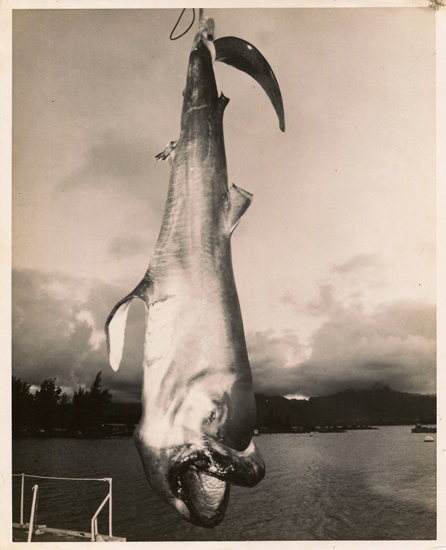
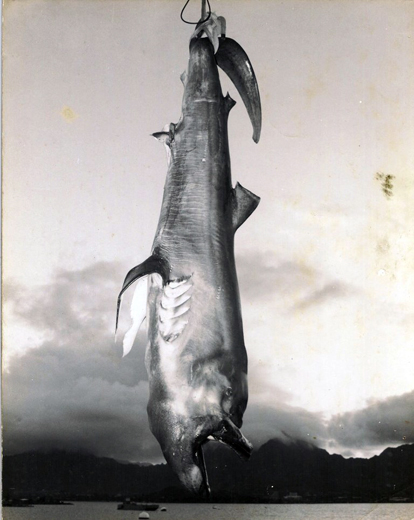
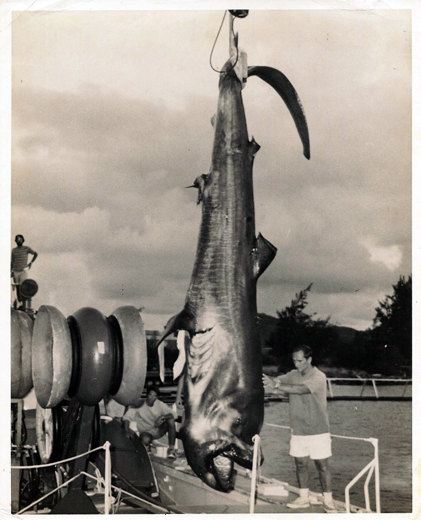
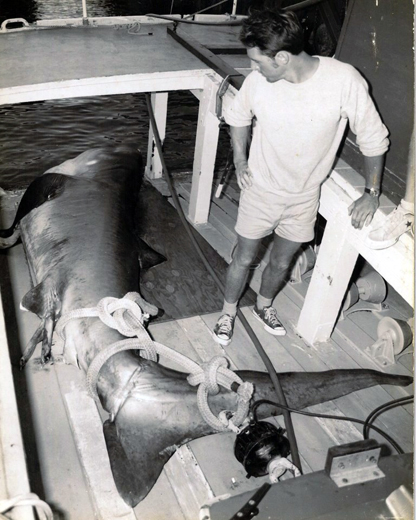
About Loren Coleman
Loren Coleman is one of the world’s leading cryptozoologists, some say “the” leading living cryptozoologist. Certainly, he is acknowledged as the current living American researcher and writer who has most popularized cryptozoology in the late 20th and early 21st centuries.
Starting his fieldwork and investigations in 1960, after traveling and trekking extensively in pursuit of cryptozoological mysteries, Coleman began writing to share his experiences in 1969. An honorary member of Ivan T. Sanderson’s Society for the Investigation of the Unexplained in the 1970s, Coleman has been bestowed with similar honorary memberships of the North Idaho College Cryptozoology Club in 1983, and in subsequent years, that of the British Columbia Scientific Cryptozoology Club, CryptoSafari International, and other international organizations. He was also a Life Member and Benefactor of the International Society of Cryptozoology (now-defunct).
Loren Coleman’s daily blog, as a member of the Cryptomundo Team, served as an ongoing avenue of communication for the ever-growing body of cryptozoo news from 2005 through 2013. He returned as an infrequent contributor beginning Halloween week of 2015.
Coleman is the founder in 2003, and current director of the International Cryptozoology Museum in Portland, Maine.










Good show.
This is awesome. Thank you.
Though some might find it ugly, I find the megamouth a phenomenal shark. It is a wonderful wonder of nature.